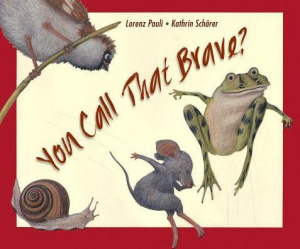 by Lorenz Pauli
by Lorenz Pauli
You Call That Brave? is the story of a mouse, a frog, a snail and a sparrow who choose feats to perform, in and around a pond, to determine who is the bravest. They discover that what is natural for one can be challenging for another. The illustrations present multiple opportunities for questioning and inferring.
Strategies/Skills Used
Reading Strategy 2: Predict what will be learned or what will happen.
Reading Strategy 4: Self-monitor and self-correct.
Reading Strategy 5: Make mental pictures.
Reading Strategy 6: Connect what you read with what you already know.
Reading Strategy 11: Make inferences and draw conclusions.
Reading Strategy 12: Reflect and respond.
Writing Skill 2: I organize my ideas based on my purpose for writing.
Writing Skill 5: I carefully choose the most effective words to express my ideas.
Writing Skill 6: I choose the tone and point of view that suit my writing purpose.
Writing Skill 7: I use my personal style to make my writing unique.
 TEACHING THE ACTIVITY: PRE-READING
TEACHING THE ACTIVITY: PRE-READING
(1) Revisit In My Heart and recall with students its celebration of feelings, specifically identifying feeling “brave.” Ask students, “What does it mean to be brave? When was a time that your heart was brave?” Connect to student responses and enable a conversation of our similarities and differences.
(2) Wonder with students, “What would it look like for an animal to be brave?”
 (3) Adapt the process of What’s In A Name?. Show students the animals on the You Call That Brave? PowerPoint and ask students, “What do you think it would look like for a frog…a bird…a snail…a mouse to be brave?”
(3) Adapt the process of What’s In A Name?. Show students the animals on the You Call That Brave? PowerPoint and ask students, “What do you think it would look like for a frog…a bird…a snail…a mouse to be brave?”
 TEACHING THE ACTIVITY: DURING READING
TEACHING THE ACTIVITY: DURING READING
(4) Show students the cover of You Call That Brave? It introduces the four animals in playful poses. Discuss with students the importance of illustrations in sharpening our comprehension process. Explain that the class is going to look deeply into the images during this read-aloud to observe more than what the words say. Invite opportunities for inference right from the beginning.
(5) Pause reading following the mouse’s challenge. Discuss and predict with students what the “fearsome feats” might be for each of the other animals.
(6) Follow the Words for Wordless process to invite students to give voice to the animal characters through the wordless pages in the text.
 TEACHING THE ACTIVITY: POST-READING
TEACHING THE ACTIVITY: POST-READING
(7) Reflect with students on our own individual differences and varied accomplishments; have students share their thinking in a think-pair-share process. Ask student partnerships to think about and report on an important aspect of the story that they would like to remember.
(8) Ask students to change their point of view and think together in partners or small groups as if they are onlookers at the pond. Ensure that students understand this new perspective and the interpretation an observer would experience.
(9) Invite student groups to create either a newspaper report or a television news bulletin to present their eyewitness account of the unusual chain of events that happened at the pond.
(10) Establish criteria for the representation of learning: the features of non-fiction, narrative text and the importance of an observer’s voice in the account.